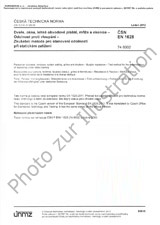Wir benötigen Ihre Einwilligung zur Verwendung der einzelnen Daten, damit Sie unter anderem Informationen zu Ihren Interessen einsehen können. Klicken Sie auf "OK", um Ihre Zustimmung zu erteilen.
ČSN ETSI EN 300392-3-13-V1.2.1 (875042)
Terrestrial Trunked Radio (TETRA); Voice plus Data (V+D); Part 3: Interworking at the Inter-System Interface (ISI); Sub-part 13: Transport layer independent Additional Network Feature Group Call (ANF-ISIGC)
Name übersetzen
NORM herausgegeben am 1.11.2020
Informationen über die Norm:
Bezeichnung normen: ČSN ETSI EN 300392-3-13-V1.2.1
Zeichen: 875042
Katalog-Nummer: 510779
Ausgabedatum normen: 1.11.2020
SKU: NS-1008305
Zahl der Seiten: 194
Gewicht ca.: 613 g (1.35 Pfund)
Land: Tschechische technische Norm
Kategorie: Technische Normen ČSN
Kategorie - ähnliche Normen:
Die Annotation des Normtextes ČSN ETSI EN 300392-3-13-V1.2.1 (875042):
V1.2.1
The present document defines the group call communication of interworking at the Inter-System Interface (ISI) for Terrestrial Trunked Radio system (TETRA) supporting Voice plus Data (V+D).
The TETRA V+D interworking - basic operation part defines the interworking between TETRA networks over the corresponding interface: the Inter-System Interface (ISI). It comprises the following sub-parts:
- - Transport Layer Independent Specification ISI general design [2];
- - General Design, PSS1 over E.1 [i.7];
- - General Design, SIP/IP [i.8];
- - Transport Layer Independent Additional Network Feature - ISI Individual Call (ANF-ISIIC) [3];
- - Transport Layer Independent Additional Network Feature Group Call (ANF-ISIGC) (the present document);
- - Transport Layer Independent Additional Network Feature Short Data service (ANF-ISISD) [i.9];
- - Transport Layer Independent Additional Network Feature Mobility Management (ANF-ISIMM) [4];
- - Generic Speech Format Implementation [i.10].
The present document is the ANF-ISIGC sub-part 3-13.
In analogy with Recommendation ITU T I.130 [i.3], the stage one, stage two and stage three of the three level structure is used to describe the TETRA Inter-System Interface services as provided by European Private or Public Trunked Radio System operators:
- - Stage 1, is an overall service description, from the service subscriber´s and user´s standpoint;
- - Stage 2, identifies the functional capabilities and information flows needed to support the services described in stage 1; and
NOTE: The information flows in stage 2 have been drawn as Message Sequence Charts (MSC).
- Stage 3, defines the signalling system protocols and functions needed to implement the services described in stage 1.
The present document details the Interworking Basic Operation of the Terrestrial Trunked Radio system (TETRA). Specifically the present document details the stage 1 aspects (overall service description) of the ANF-ISIGC as seen from the TETRA Switching and Maintenance Infrastructure point of view at the Inter-System Interface (ISI). It details the stage 2 aspects (functional partitioning) of ANF-ISIGC which includes the identification of the functional entities and the flows between them, and finally it details the stage 3 signalling protocols for the ANF-ISIGC services, i.e. the protocols at the relevant reference points between the functional entities defined in stage 2.
The ANF-ISIGC service specifies:
- - TETRA Group Call Clear Speech over the ISI, acknowledged and unacknowledged;
- - TETRA Group Call End-to-End Encrypted Speech over the ISI;
- - TETRA Group Call Circuit Mode one slot data over the ISI;
- - TETRA Group Call Circuit Mode one slot End-to-End Encrypted data over the ISI;
- - TETRA Group Call Circuit Mode N × 2,4 kbit/s, N × 4,8 kbit/s or N × 7,2 kbit/s data, with N = 2, 3 or 4;
- - TETRA Group Call Circuit Mode N × 2,4 kbit/s N × 4,8 kbit/s or N × 7,2 kbit/s End-to-End Encrypted data, with N = 2, 3 or 4
Normansicht ČSN ETSI EN 300392-3-13-V1.2.1 (875042)
Empfehlungen:
Aktualisierung der technischen Normen
Wollen Sie sich sicher sein, dass Sie nur die gültigen technischen Normen verwenden?
Wir bieten Ihnen eine Lösung, die Ihnen eine Monatsübersicht über die Aktualität der von Ihnen angewandten Normen sicher stellt.
Brauchen Sie mehr Informationen? Sehen Sie sich diese Seite an.




 Cookies
Cookies
